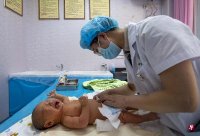"The Capital of Small Commodities in the World" in Zhejiang Yiwu City has been relieved. From Wednesday (August 24), the city's epidemic points have been lifted and controlled, and the normalized epidemic prevention and control will be fully restored.
According to the announcement of the WeChat account of "Yiwu", the local production and operation venues are fully restored.Various professional markets, farmers' (agricultural batch) markets, vegetable markets, supermarkets, tourist attractions, catering venues and pension service agencies, children's welfare institutions, religious places, home care care centers, and other orderly restoration of normal operations.Theater, KTV, Internet cafes, game halls, gyms, cinemas, bars, chess rooms, billiard rooms, bathrooms, foot bathrooms, beauty hairdressing, tea rooms, cafes, board games, SPA pavilions and other key placesEssenceEnter various types of public places to implement temperature measurement, wearing masks, and scanning three inspections (scan the yard, check the health code, itinerary card, 48 -hour kernel acid test negative certificate) and other epidemic prevention requirements.
The announcement also mentioned that activities such as banquet exhibitions were regulated.Organizing clustering activities such as meetings, forums, training, performances, competitions, examinations, banquets, etc., the list of participants must be grasped in advance, and the personnel of the risk zone must be rejected.If the personnel size exceeds 50 people, the organizer needs to formulate the epidemic prevention and control plan and report to the area of the epidemic prevention and control of the local town; if more than 200 people, the principle of "who holds who is responsible" and "who organizes and who is responsible",The organizer and the organizer (organization) shall fulfill the main responsibility, formulate the epidemic prevention and control work plan and emergency plan in advance, and implement the full chain of the full chain to traceable management.In addition, local public transportation will be fully restored.
The notification requirements are not necessary to go to the epidemic risk area, strictly implement the requirements of wearing masks, one meter line, and scanning yards, and check the requirements of health code, itinerary card and nucleic acid detection negative certificate.
Chongqing's epidemic in the municipality of China's municipality continues.There were 21 new local diagnosis cases on Tuesday (August 23) and 19 cases of non -symptom -free infection.From 6 o'clock on August 24th, Chongqing will carry out a round of nucleic acid screening on citizens in the city center, and will be completed that day.
As of 24:00 on August 23, there were 74 local confirmed cases in Chongqing, and 72 cases of infected infected infected with existing natives.
382 newly confirmed cases were added on Monday (August 22).Of these local cases, 308 cases, including 205 cases in Hainan, 27 cases in Tibet, and 23 cases in Chongqing.
The remaining local cases are distributed in: 13 cases in Shaanxi, 7 cases in Guangdong, 6 cases in Sichuan, 4 cases in Fujian, 4 cases in Xinjiang, 3 cases in Henan, 3 cases in Hubei, 2 cases in Shanxi, 2 cases in Inner Mongolia, Hunan 2 cases, HunanTwo cases, 2 cases of Yunnan, 2 cases of Qinghai, 1 case in Shanghai, 1 case in Zhejiang, and 1 case in Jiangxi, including 65 cases of those who were infected from asymptomatic to confirmed cases.
There were 1,513 newly added infected infected Monday, including 1,440 cases, including 520 cases in Hainan, 518 cases in Tibet, 173 cases in Xinjiang, 77 cases in Shaanxi, 54 cases in Qinghai, 23 cases in Gansu, Henan 11, 11For example, 8 cases in Anhui, 8 cases in Hubei, 8 cases of Chongqing, 7 cases in Jiangxi, 7 cases in Sichuan, 5 cases of Heilongjiang, 5 cases of Guangxi, 5 cases in Shanghai, 3 cases in Shanghai, 2 cases in Liaoning, 1 case of Shanxi, 1 case of Inner Mongolia, 1 case of 1 case, 1 case in Inner Mongolia, 1 case of 1 case, 1 case in Inner Mongolia, 1 case, 1 case, 1 case, 1 case of Inner Mongolia.1 case of Jilin, 1 case in Zhejiang, 1 case in Guangdong, and 1 case in Guizhou.
As of August 22, there were 8,391 confirmed cases in mainland China, of which 35 were in severe cases.


